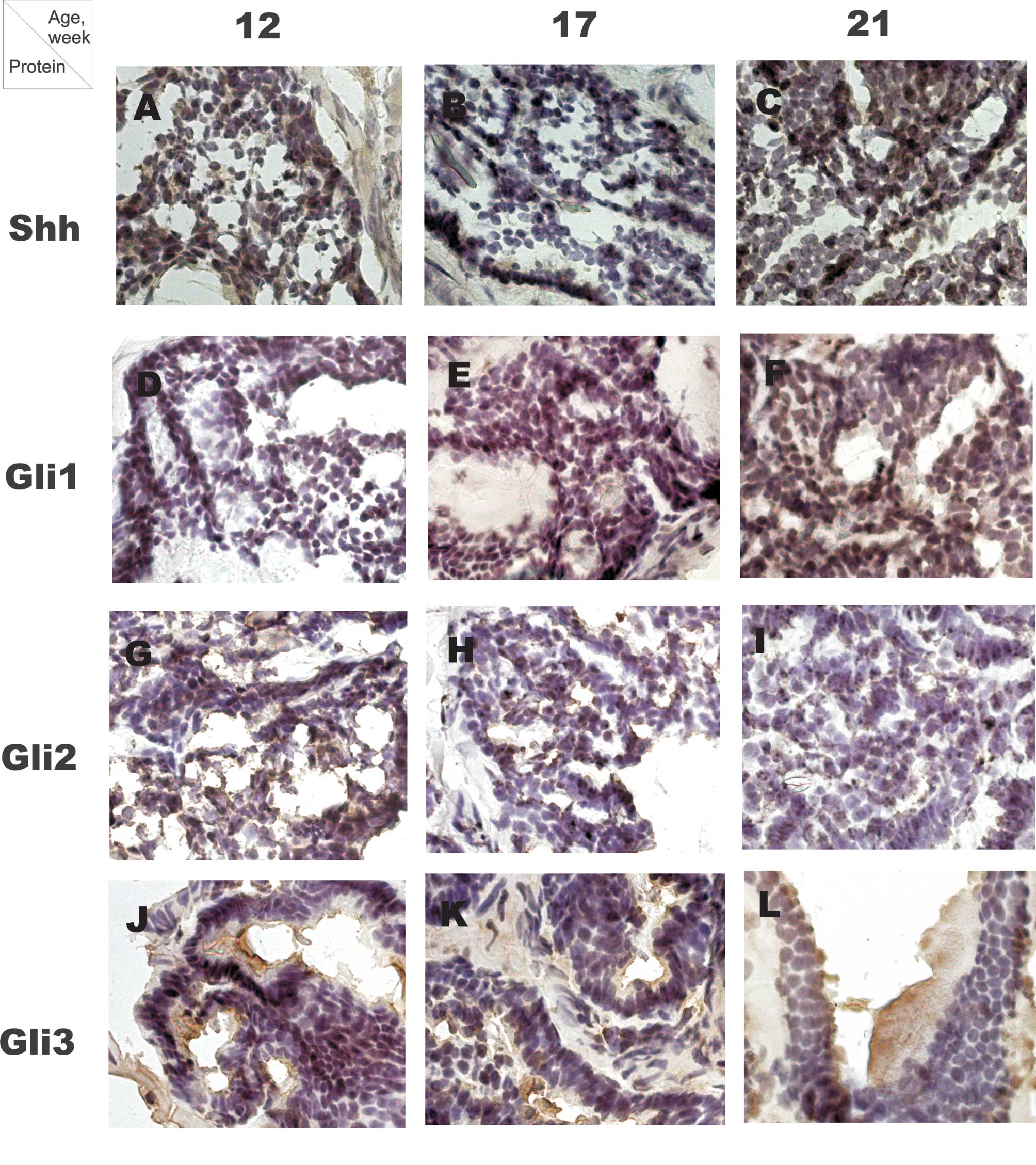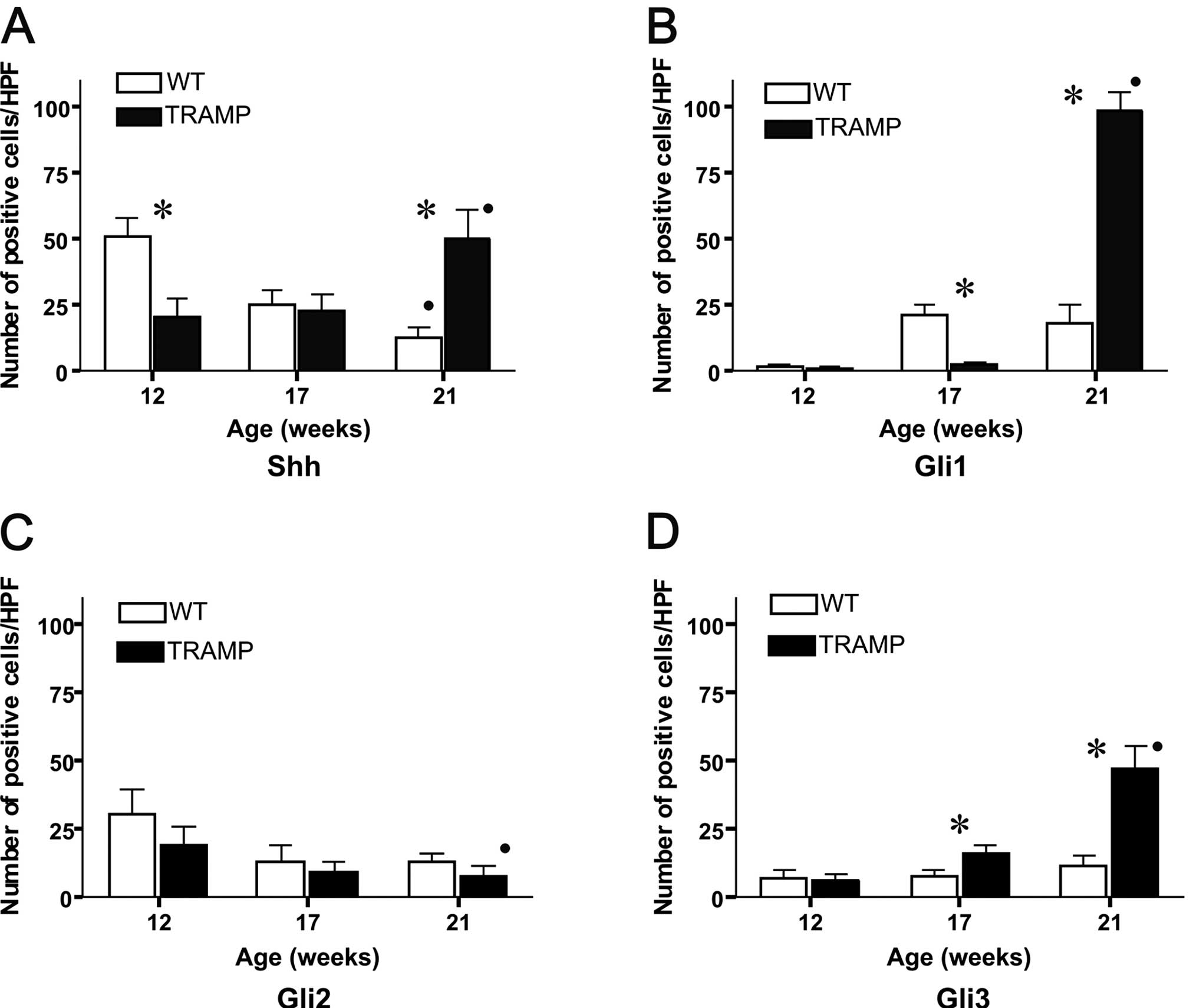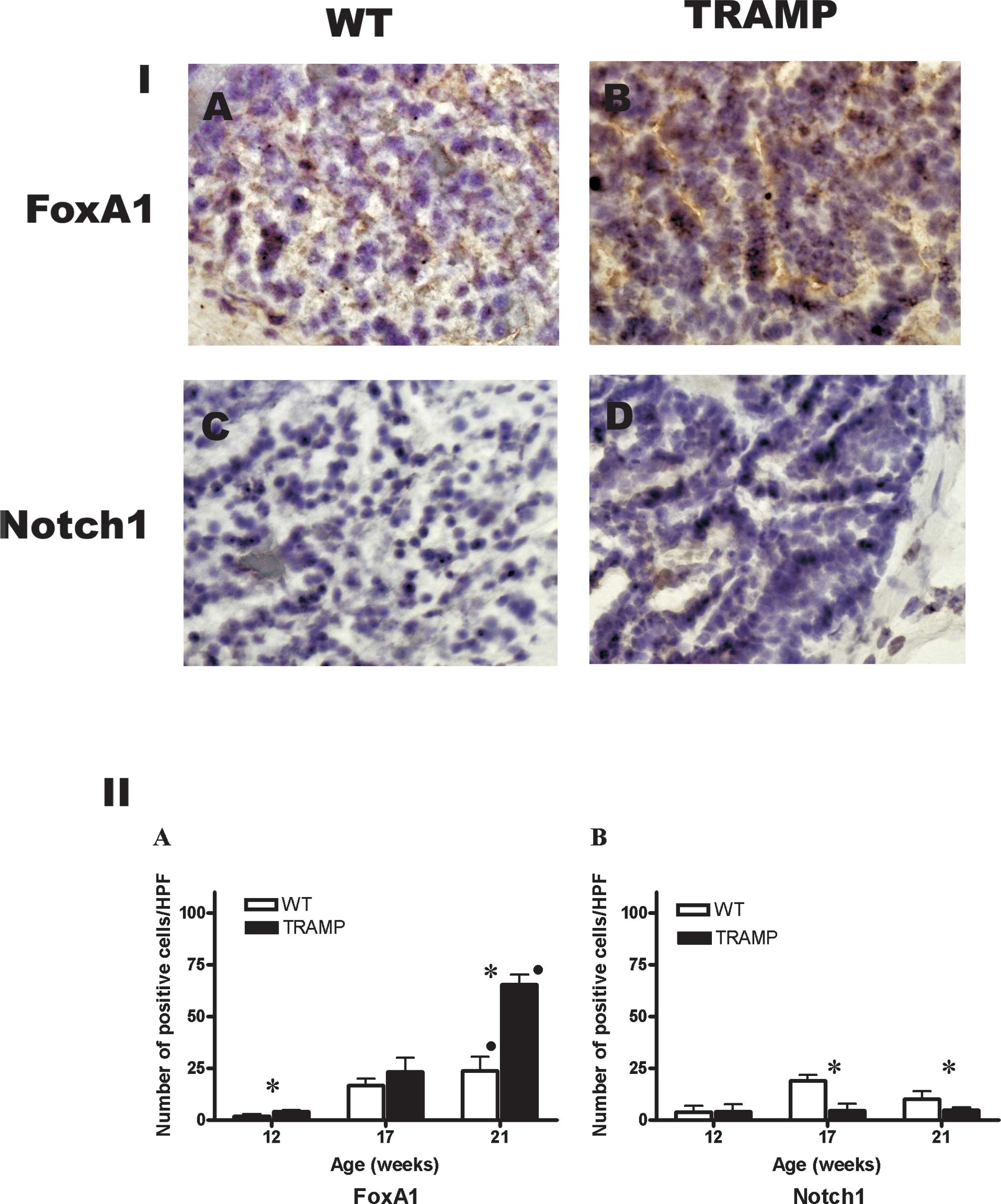|
1
|
Osterlund T and Kogerman P: Hedgehog
signalling: how to get from Smo to Ci and Gli. Trends Cell Biol.
16:176–180. 2006. View Article : Google Scholar : PubMed/NCBI
|
|
2
|
Chung UI, Schipani E, McMahon AP and
Kronenberg HM: Indian hedgehog couples chondrogenesis to
osteogenesis in endochondral bone development. J Clin Invest.
107:295–304. 2001. View
Article : Google Scholar : PubMed/NCBI
|
|
3
|
Sharghi-Namini S, Turmaine M, Meier C, et
al: The structural and functional integrity of peripheral nerves
depends on the glial-derived signal desert hedgehog. J Neurosci.
26:6364–6376. 2006. View Article : Google Scholar : PubMed/NCBI
|
|
4
|
Bitgood MJ, Shen L and McMahon AP: Sertoli
cell signaling by Desert hedgehog regulates the male germline. Curr
Biol. 6:298–304. 1996. View Article : Google Scholar : PubMed/NCBI
|
|
5
|
Kinzler KW, Ruppert JM, Bigner SH and
Vogelstein B: The GLI gene is a member of the Kruppel family of
zinc finger proteins. Nature. 332:371–374. 1988. View Article : Google Scholar : PubMed/NCBI
|
|
6
|
Ruppert JM, Kinzler KW, Wong AJ, et al:
The GLI-Kruppel family of human genes. Mol Cell Biol. 8:3104–3113.
1988.PubMed/NCBI
|
|
7
|
Rowitch DH, BSJ, Lee SM, Flax JD, Snyder
EY and McMahon AP: Sonic hedgehog regulates proliferation and
inhibits differentiation of CNS precursor cells. J Neurosci.
19:8954–8965. 1999.PubMed/NCBI
|
|
8
|
Bhardwaj G, Murdoch B, Wu D, et al: Sonic
hedgehog induces the proliferation of primitive human hematopoietic
cells via BMP regulation. Nat Immunol. 2:172–180. 2001. View Article : Google Scholar : PubMed/NCBI
|
|
9
|
Stecca B, Mas C and Ruiz i Altaba A:
Interference with HH-GLI signaling inhibits prostate cancer. Trends
Mol Med. 11:199–203. 2005. View Article : Google Scholar : PubMed/NCBI
|
|
10
|
Karhadkar SS, Bova GS, Abdallah N, et al:
Hedgehog signalling in prostate regeneration, neoplasia and
metastasis. Nature. 431:707–712. 2004. View Article : Google Scholar : PubMed/NCBI
|
|
11
|
Ruiz i Altaba A: Therapeutic inhibition of
Hedgehog-GLI signaling in cancer: epithelial, stromal, or stem cell
targets? Cancer Cell. 14:281–283. 2008.PubMed/NCBI
|
|
12
|
Oldak M, Grzela T, Lazarczyk M, Malejczyk
J and Skopinski P: Clinical aspects of disrupted Hedgehog signaling
(Review). Int J Mol Med. 8:445–452. 2001.PubMed/NCBI
|
|
13
|
Datta S and Datta MW: Sonic Hedgehog
signaling in advanced prostate cancer. Cell Mol Life Sci.
63:435–448. 2006. View Article : Google Scholar : PubMed/NCBI
|
|
14
|
Sanchez P, Hernandez AM, Stecca B, et al:
Inhibition of prostate cancer proliferation by interference with
Sonic Hedgehog-Gli1 signaling. Proc Natl Acad Sci USA.
101:12561–12566. 2004. View Article : Google Scholar : PubMed/NCBI
|
|
15
|
Sheng T, Li C, Zhang X, et al: Activation
of the hedgehog pathway in advanced prostate cancer. Mol Cancer.
3:292004. View Article : Google Scholar : PubMed/NCBI
|
|
16
|
Gipp J, Gu G, Crylen C, Kasper S and
Bushman W: Hedgehog pathway activity in the LADY prostate tumor
model. Mol Cancer. 6:192007. View Article : Google Scholar : PubMed/NCBI
|
|
17
|
Mukherjee S, Frolova N, Sadlonova A, et
al: Hedgehog signaling and response to cyclopamine differ in
epithelial and stromal cells in benign breast and breast cancer.
Cancer Biol Ther. 5:674–683. 2006. View Article : Google Scholar : PubMed/NCBI
|
|
18
|
Zhao J, Chen G, Cao D, et al: Expression
of Gli1 correlates with the transition of breast cancer cells to
estrogen-independent growth. Breast Cancer Res Treat. 119:39–51.
2010. View Article : Google Scholar : PubMed/NCBI
|
|
19
|
Nielsen SK, Mollgard K, Clement CA, et al:
Characterization of primary cilia and Hedgehog signaling during
development of the human pancreas and in human pancreatic duct
cancer cell lines. Dev Dyn. 237:2039–2052. 2008. View Article : Google Scholar : PubMed/NCBI
|
|
20
|
Hunt R, Bragina O, Drews M, et al:
Generation and characterization of mouse monoclonal antibody 5E1
against human transcription factor GLI3. Hybridoma (Larchmt).
26:231–240. 2007. View Article : Google Scholar
|
|
21
|
Unger S, Copland I, Tibboel D and Post M:
Down-regulation of sonic hedgehog expression in pulmonary
hypoplasia is associated with congenital diaphragmatic hernia. Am J
Pathol. 162:547–555. 2003. View Article : Google Scholar : PubMed/NCBI
|
|
22
|
Wang BE, Shou J, Ross S, Koeppen H, De
Sauvage FJ and Gao WQ: Inhibition of epithelial ductal branching in
the prostate by sonic hedgehog is indirectly mediated by stromal
cells. J Biol Chem. 278:18506–18513. 2003. View Article : Google Scholar : PubMed/NCBI
|
|
23
|
Minoo P, Hu L, Zhu N, et al: SMAD3
prevents binding of NKX2.1 and FOXA1 to the SpB promoter through
its MH1 and MH2 domains. Nucleic Acids Res. 36:179–188. 2008.
View Article : Google Scholar : PubMed/NCBI
|
|
24
|
Fox V, Gokhale PJ, Walsh JR, Matin M,
Jones M and Andrews PW: Cell-cell signaling through NOTCH regulates
human embryonic stem cell proliferation. Stem Cells. 26:715–723.
2008. View Article : Google Scholar : PubMed/NCBI
|
|
25
|
Djalilian AR, Namavari A, Ito A, et al:
Down-regulation of Notch signaling during corneal epithelial
proliferation. Mol Vis. 14:1041–1049. 2008.PubMed/NCBI
|
|
26
|
Maini A, Archer C, Wang CY and Haas GP:
Comparative pathology of benign prostatic hyperplasia and prostate
cancer. In Vivo. 11:293–299. 1997.PubMed/NCBI
|
|
27
|
Cunha GR, Donjacour AA, Cooke PS, et al:
The endocrinology and developmental biology of the prostate. Endocr
Rev. 8:338–362. 1987. View Article : Google Scholar : PubMed/NCBI
|
|
28
|
Gingrich JR, Barrios RJ, Morton RA, et al:
Metastatic prostate cancer in a transgenic mouse. Cancer Res.
56:4096–4102. 1996.PubMed/NCBI
|
|
29
|
Gingrich JR, Barrios RJ, Kattan MW, Nahm
HS, Finegold MJ and Greenberg NM: Androgen-independent prostate
cancer progression in the TRAMP model. Cancer Res. 57:4687–4691.
1997.PubMed/NCBI
|
|
30
|
Kasper S, Sheppard PC, Yan Y, et al:
Development, progression and androgen-dependence of prostate tumors
in probasin-large T antigen transgenic mice: a model for prostate
cancer. Lab Invest. 78:319–333. 1998.
|
|
31
|
Abate-Shen C and Shen MM: Mouse models of
prostate carcinogenesis. Trends Genet. 18:S1–S5. 2002. View Article : Google Scholar : PubMed/NCBI
|
|
32
|
Sasaki H, Nishizaki Y, Hui C, Nakafuku M
and Kondoh H: Regulation of Gli2 and Gli3 activities by an
amino-terminal repression domain: implication of Gli2 and Gli3 as
primary mediators of Shh signaling. Development. 126:3915–3924.
1999.PubMed/NCBI
|
|
33
|
Dai P, Akimaru H, Tanaka Y, Maekawa T,
Nakafuku M and Ishii S: Sonic Hedgehog-induced activation of the
Gli1 promoter is mediated by GLI3. J Biol Chem. 274:8143–8152.
1999. View Article : Google Scholar : PubMed/NCBI
|
|
34
|
Wang C, Ruther U and Wang B: The
Shh-independent activator function of the full-length Gli3 protein
and its role in vertebrate limb digit patterning. Dev Biol.
305:460–469. 2007. View Article : Google Scholar : PubMed/NCBI
|
|
35
|
Mirosevich J, Gao N, Gupta A, Shappell SB,
Jove R and Matusik RJ: Expression and role of Foxa proteins in
prostate cancer. Prostate. 66:1013–1028. 2006. View Article : Google Scholar : PubMed/NCBI
|
|
36
|
Gao N, Ishii K, Mirosevich J, et al:
Forkhead box A1 regulates prostate ductal morphogenesis and
promotes epithelial cell maturation. Development. 132:3431–3443.
2005. View Article : Google Scholar : PubMed/NCBI
|
|
37
|
Wang XD, Leow CC, Zha J, et al: Notch
signaling is required for normal prostatic epithelial cell
proliferation and differentiation. Dev Biol. 290:66–80. 2006.
View Article : Google Scholar
|
|
38
|
Leong KG and Gao WQ: The Notch pathway in
prostate development and cancer. Differentiation. 76:699–716. 2008.
View Article : Google Scholar : PubMed/NCBI
|
|
39
|
Shou J, Ross S, Koeppen H, de Sauvage FJ
and Gao WQ: Dynamics of notch expression during murine prostate
development and tumorigenesis. Cancer Res. 61:7291–7297.
2001.PubMed/NCBI
|
|
40
|
Bolos V, Grego-Bessa J and de la Pompa JL:
Notch signaling in development and cancer. Endocr Rev. 28:339–363.
2007. View Article : Google Scholar : PubMed/NCBI
|













